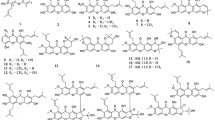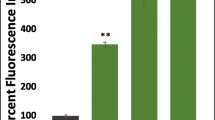Abstract
Gedunin is a natural tetranorterpenoid secondary metabolite found in plants of the Meliaceae family, which has been reported for its antiparasitic, antifungal and anticancer activities. Here, we describe the molecular mechanisms underlying the in vitro anti proliferative activity of gedunin (isolated from the mangrove plant Xylocarpus granatum) in human ovarian cancer cells. We observed that gedunin triggered severe ROS generation leading to DNA damage and cell cycle arrest in G2/M phase thus inhibiting cell proliferation. ROS upregulation also led to mitochondrial stress and membrane depolarization, which eventually resulted in mitochondria-mediated apoptosis following cytochrome C release, caspase 9, 3 activation, and PARP cleavage. Transmission electron microscopy of gedunin treated cells revealed sub-cellular features typical of apoptosis. Moreover, an upregulation in stress kinases like phospho-ERK 1/2, phospho-p38 and phospho-JNK was also observed in gedunin treated cells. Free radical scavenger N-Acetyl-L-Cysteine (NAC) reversed all these effects resulting in increased cell survival, abrogation of cell cycle arrest, rescue of mitochondrial membrane potential and suppression of apoptotic markers. Interestingly, gedunin is also an inhibitor of the evolutionarily conserved molecular chaperone Heat Shock Protein 90 (hsp90) responsible for maintaining cellular homeostasis. Targeting this chaperone could be an attractive strategy for developing cancer therapeutics since many oncogenic proteins are also client proteins of hsp90. Collectively, our findings provide insights into the molecular mechanism of action of gedunin, which may aid drug development efforts against ovarian cancer.








Similar content being viewed by others
References
Reid BM, Permuth JB, Sellers TA (2017) Epidemiology of ovarian cancer: a review. Cancer Biol Med 14:9–32. https://doi.org/10.20892/j.issn.2095-3941.2016.0084
Maheshwari A, Kumar N, Mahantshetty U (2016) Gynecological cancers: a summary of published Indian data. South Asian J Cancer 5(3):112–120. https://doi.org/10.4103/2278-330X.187574
https://seer.cancer.gov. Cancer Stat Facts: Ovarian Cancer. NIH National Cancer Intitute
Li SS, Ma J, Wong AST (2018) Chemoresistance in ovarian cancer: exploiting cancer stem cell metabolism. J Gynecol Oncol 29(2):1–11. https://doi.org/10.3802/jgo.2018.29.e32
Mileo AM, Miccadei S (2016) Polyphenols as modulator of oxidative stress in cancer disease: new therapeutic strategies. Oxid Med Cell Longev 2016(1):17
Hasanain M, Bhattacharjee A, Pandey P et al (2015) α -Solanine induces ROS-mediated autophagy through activation of endoplasmic reticulum stress and inhibition of Akt/mTOR pathway. Cell Death Dis 6(8):e1860–e1814. https://doi.org/10.1038/cddis.2015.219
Yao W, Lin Z, Shi P, Chen B, Wang G, Huang J (2020) Delica fl avone induces ROS-mediated apoptosis and inhibits PI3K/AKT/mTOR and Ras/MEK/Erk signaling pathways in colorectal cancer cells. Biochem Pharmacol 171(October 2019):113680. https://doi.org/10.1016/j.bcp.2019.113680
Kuttan G, Pratheeshkumar P, Manu KA et al (2011) Inhibition of tumor progression by naturally occurring terpenoids Inhibition of tumor progression by naturally occurring terpenoids. Pharm Biol 49(10):995–1007. https://doi.org/10.3109/13880209.2011.559476
Patwardhan CA, Fauq A, Peterson LB, Miller C, Blagg BSJ, Chadli A (2013) Gedunin inactivates the co-chaperone p23 protein causing cancer cell death by apoptosis. J Biol Chem 288(10):7313–7325. https://doi.org/10.1074/jbc.M112.427328
Uddin SJ, Nahar L, Shilpi JA et al (2007) Gedunin, a limonoid from xylocarpus granatum, inhibits the growth of CaCo-2 colon cancer cell line in vitro. Phyther Res 761(21):757–761. https://doi.org/10.1002/ptr
Brandt GEL, Schmidt MD, Prisinzano TE, Blagg BSJ (2008) Gedunin, a novel hsp90 inhibitor: semisynthesis of derivatives and preliminary structure–activity relationships. J Med Chem 51(20):6495–6502. https://doi.org/10.1021/jm8007486.Gedunin
Ponnusamy S, Haldar S, Mulani F, Zinjarde S, Thulasiram H, RaviKumar A (2015) Gedunin and azadiradione: human pancreatic alpha-amylase inhibiting limonoids from neem (Azadirachta indica) as anti-diabetic agents. PLoS ONE 10(10):e0140113. https://doi.org/10.1371/journal.pone.0140113
Ferraris FK, Moret KH, Figueredo ABC, Penido C, Maria das Gracas MO (2012) Gedunin, a natural tetranortriterpenoid, modulates T lymphocyte responses and ameliorates allergic inflammation. Int Immunopharmacol 14(1):82–93. https://doi.org/10.1016/j.intimp.2012.06.002
Tharmarajah L, Samarakoon SR, Ediriweera MK et al (2017) In vitro anticancer effect of gedunin on human teratocarcinomal (NTERA-2) cancer stem-like cells. Hindawi BioMed Res Int 2017:1–9
Subramani R, Gonzalez E, Nandy SB et al (2017) Gedunin inhibits pancreatic cancer by altering sonic hedgehog signaling pathway. Oncotarget 8(7):10891–10904
Kamath SG, Chen ÞN, Xiong ÞY et al (2009) Gedunin, a novel natural substance, inhibits ovarian cancer cell proliferation. Int J Gynecol cancer 19(9):1564–1569. https://doi.org/10.1111/IGC.0b013e3181a83135
Misra S, Verma M, Mishra SK, Srivastava S, Lakshmi V, Misra-Bhattacharya S (2011) Gedunin and photogedunin of Xylocarpus granatum possess antifilarial activity against human lymphatic filarial parasite Brugia malayi in experimental rodent host. Parasitol Res 109(5):1351–1360. https://doi.org/10.1007/s00436-011-2380-x
Hanahan D, Weinberg RA (2011) Hallmarks of cancer: the next generation. Cell 144(5):646–674. https://doi.org/10.1016/j.cell.2011.02.013
Williams GH, Stoeber K (2012) The cell cycle and cancer. J Pathol 226:352–364. https://doi.org/10.1016/B978-0-12-370458-0.50014-1
Sabharwal SS, Schumacker PT (2014) Mitochondrial ROS in cancer: Initiators, amplifiers or an Achilles’ heel? Nat Rev Cancer 14(11):709–721. https://doi.org/10.1038/nrc3803
Elmore S, Apoptosis (2007) A review of programmed cell death. Toxicol Pathol 35(4):495–516. https://doi.org/10.1080/01926230701320337
Skehan P, Storeng R, Scudiero D et al (1990) New colorimetric cytotoxicity assay for anticancer-drug screening. J Natl Cancer Inst 82(13):1107–1112. https://doi.org/10.1093/jnci/82.13.1107
Liang CC, Park AY, Guan JL (2007) In vitro scratch assay: a convenient and inexpensive method for analysis of cell migration in vitro. Nat Protoc 2(2):329–333. https://doi.org/10.1038/nprot.2007.30
Riccardi C, Nicoletti I (2006) Analysis of apoptosis by propidium iodide staining and flow cytometry. Nat Protoc 1(3):1458–1461. https://doi.org/10.1038/nprot.2006.238
Hasanain M, Sahai R, Pandey P et al (2020) Microtubule disrupting agent-mediated inhibition of cancer cell growth is associated with blockade of autophagic flux and simultaneous induction of apoptosis. Cell Prolif 53(4):e12749. https://doi.org/10.1111/cpr.12749
Kathuria M, Bhattacharjee A, Sashidhara KV, Singh SP, Mitra K (2014) Induction of mitochondrial dysfunction and oxidative stress in leishmania donovani by orally active clerodane diterpene. Antimicrob Agents Chemother 58(10):5916–5928. https://doi.org/10.1128/AAC.02459-14
Vermes I, Haanen C, Steffens-Nakken H, Reutellingsperger C (1995) A novel assay for apoptosis flow cytometric detection of phosphatidylserine expression on early apoptotic cells using fluorescein labelled Annexin V. J Immunol Methods 184(1):39–51. https://doi.org/10.1016/0022-1759(95)00072-I
Bhattacharjee A, Hasanain M, Kathuria M, Singh A (2018) Ormeloxifene-induced unfolded protein response contributes to autophagy-associated apoptosis via disruption of Akt/mTOR and activation of JNK. Sci Rep 8(2303):1–13. https://doi.org/10.1038/s41598-018-20541-8
DiPaola RS (2002) To arrest or not to G2-M cell-cycle arrest. Clin Cancer Res 8(November):3311–3314
Ando T, Kawabe T, Ohara H, Ducommun B, Itoh M, Okamoto T (2001) Involvement of the interaction between p21 and proliferating cell nuclear antigen for the maintenance of G 2/M arrest after DNA damage. J Biol Chem 276(46):42971–42977. https://doi.org/10.1074/jbc.M106460200
Sakaguchi K, Herrera JE, Saito S et al (1998) DNA damage activates p53 through a phosphorylation—acetylation cascade. Genes Dev 12:2831–2841
Sharma A, Singh K, Almasan A (2012) Histone H2AX phosphorylation: a marker for DNA damage. In: DNA repair protocols. Methods in Springer, pp 1–11. https://doi.org/10.1007/978-1-61779-998-3_40
Zorova LD, Popkov VA, Plotnikov EY et al (2018) Mitochondrial membrane potential. Anal Biochem 552:50–59. https://doi.org/10.1016/j.ab.2017.07.009
Tait SWG, Green DR (2013) Mitochondrial regulation of cell death. Cold Spring Harb Perspect Biol 5:75–90. https://doi.org/10.1101/cshperspect.a008706
Tait SWG, Green DR (2010) Mitochondria and cell death: outer membrane permeabilization and beyond. Nat Rev Mol Cell Biol 11(9):621–632. https://doi.org/10.1038/nrm2952
Morrison DK (2012) MAP kinase pathways. Cold Spring Harb Perspect Biol 4(11):a011254
Liu J, Lin A (2005) Role of JNK activation in apoptosis: a double-edged sword. Cell Res 15(1):36–42
Https://www.picard.ch/downloads/Hsp90interactors.pdf. Hsp90 Interactors
Wang J, Luo B, Li X et al (2017) Inhibition of cancer growth in vitro and in vivo by a novel ROS-modulating agent with ability to eliminate stem-like cancer cells. Cell Death Dis e2887:1–9. https://doi.org/10.1038/cddis.2017.272
Trepel J, Mollapour M, Giaccone G, Neckers L (2010) Targeting the dynamic HSP90 complex in cancer. Nat Rev Cancer 10(8):537–549. https://doi.org/10.1038/nrc2887
Williams AB, Schumacher B (2016) p53 in the DNA-damage-repair process. Cold Spring Harb Perspect Med 6(5):1–16. https://doi.org/10.1101/cshperspect.a026070
Wang Z, Yu K, Hu Y et al (2019) Schisantherin A induces cell apoptosis through ROS/JNK signaling pathway in human gastric cancer cells. Biochem Pharmacol 173:113673. https://doi.org/10.1016/j.bcp.2019.113673
Liu L, Zhu H, Wu W et al (2019) Neoantimycin F, a streptomyces—derived natural product induces mitochondria-related apoptotic death in human non-small cell lung cancer cells. Front Pharmacol 10(September):1–13. https://doi.org/10.3389/fphar.2019.01042
Zhang X, Jiang J, Chen Z, Cao M (2019) Silibinin inhibited autophagy and mitochondrial apoptosis in pancreatic carcinoma by activating JNK / SAPK signaling. Pathol Res Pract 215(9):152530. https://doi.org/10.1016/j.prp.2019.152530
Wang J, Shen G, Luo Y et al (2019) 2-(4-methoxyphenylthio)-5,8-dimethoxy-1,4-naphthoquinone induces apoptosis via ROS mediated MAPK and STAT3 signaling pathway in human gastric cancer cells. J Chemother 31(4):214–226. https://doi.org/10.1080/1120009X.2019.1610832
Liu C, Shen G-N, Luo Y-H et al (2020) Novel 1,4-naphthoquinone derivatives induce apoptosis via ROS-mediated p38/MAPK, Akt and STAT3 signaling in human hepatoma Hep3B cells. Int J Biochem Cell Biol 96:9–19
Basu S, Rajakaruna S, Reyes B et al (2014) Suppression of MAPK/JNK-MTORC1 signaling leads to premature loss of organelles and nuclei by autophagy during terminal differentiation of lens fiber cells. Autophagy 10(7):1193–1211. https://doi.org/10.4161/auto.28768
Cuyàs E, Corominas-Faja B, Joven J, Menendez JA (2014) Cell cycle regulation by the nutrient-sensing mammalian target of rapamycin (mTOR) Pathway. In: Cell cycle control, methods in molecular biology (methods and protocols). vol 1170. Humana Press, New York, pp 113–144
Ha G-H, Park J-S, Breuer E-KY (2013) TACC3 promotes epithelial-mesenchymal transition (EMT) through the activation of PI3K/Akt and ERK signaling pathways. Cancer Lett 332(1):63–73
Kim S, Kim K, Park S et al (2017) Mitochondrial ROS activates ERK/autophagy pathway as a protected mechanism against deoxypodophyllotoxin-induced apoptosis. Oncotarget 8(67):111581–111596
Santucci R, Sinibaldi F, Cozza P, Polticelli F, Fiorucci L (2019) Cytochrome c: an extreme multifunctional protein with a key role in cell fate. Int J Biol Macromol 136:1237–1246. https://doi.org/10.1016/j.ijbiomac.2019.06.180
Shen HM, Liu ZG (2006) JNK signaling pathway is a key modulator in cell death mediated by reactive oxygen and nitrogen species. Free Radic Biol Med 40(6):928–939. https://doi.org/10.1016/j.freeradbiomed.2005.10.056
Chambers JW, LoGrasso PV (2011) Mitochondrial c-Jun N-terminal Kinase (JNK) signaling initiates physiological changes resulting in amplification of reactive oxygen species generation. J Biol Chem 286(18):16052–16062. https://doi.org/10.1074/jbc.M111.223602
Tsuruta F, Sunayama J, Mori Y et al (2004) JNK promotes Bax translocation to mitochondria through phosphorylation of 14-3-3 proteins. EMBO J 23(8):1889–1899. https://doi.org/10.1038/sj.emboj.7600194
Whitesell L, Lindquist SL (2005) HSP90 and the chaperoning. Nat Rev Cancer 5:761–772. https://doi.org/10.1038/nrc1716
Gaspar N, Sharp SY, Eccles SA et al (2010) Mechanistic evaluation of the novel HSP90 inhibitor NVP-AUY922 in adult and pediatric glioblastoma. Mol Cancer Ther 9(5):1219–1233. https://doi.org/10.1158/1535-7163.MCT-09-0683
Nagaraju GP, Mezina A, Shaib WL, Landry J, El-Rayes BF (2016) Targeting the Janus-activated kinase-2-STAT3 signalling pathway in pancreatic cancer using the HSP90 inhibitor ganetespib. Eur J Cancer 52:109–119. https://doi.org/10.1016/j.ejca.2015.10.057
Boridy S, Le PU, Petrecca K, Maysinger D (2014) Celastrol targets proteostasis and acts synergistically with a heat-shock protein 90 inhibitor to kill human glioblastoma cells. Cell Death Dis 5(e1216):1–12. https://doi.org/10.1038/cddis.2014.182
Zhang Z, Miao L, Lv C et al (2013) Wentilactone B induces G2/M phase arrest and apoptosis via the Ras/Raf/MAPK signaling pathway in human hepatoma SMMC-7721 cells. Cell Death Dis. 4(6):e657. https://doi.org/10.1038/cddis.2013.182
Rouf R, Uddin SJ, Shilpi JA, Alamgir M (2007) Assessment of antidiarrhoeal activity of the methanol extract of Xylocarpus granatum bark in mice model. J Ethnopharmacol 109(3):539–542. https://doi.org/10.1016/j.jep.2006.08.015
Acknowledgements
Technical assistance from Ms. Garima Pant and Mrs. Madhuli Srivastava for EM specimen preparation at EM Unit SAIF-R CDRI; and Mr. AL Vishwakarma and Mrs. Madhu Chaturvedi for flow-cytometer analysis, SAIF-R CDRI is acknowledged. This is CDRI communication number 10065.
Funding
Funding support from CSIR network project BSC0120 and institutional project OLP0101 to KM, fellowship DBT-SRF to RS, CSIR-SRF to AB, CSIR-SRF to PY and ICMR-SRF to MH is duly acknowledged.
Author information
Authors and Affiliations
Contributions
RS performed most of the experiments, prepared figures and wrote the first draft of the manuscript; AB performed some experiments and edited manuscript; VNS, PY, TN isolated gedunin; JS provided critical inputs and shared resources; MH performed cell viability assay supervised by JS; TN and KM conceived the study; KM supervised the study, interpreted data, arranged funding, edited and finalized the manuscript.
Corresponding author
Ethics declarations
Conflict of interest
The authors declare that there are no conflicts of interest.
Additional information
Publisher's Note
Springer Nature remains neutral with regard to jurisdictional claims in published maps and institutional affiliations.
Rights and permissions
About this article
Cite this article
Sahai, R., Bhattacharjee, A., Shukla, V.N. et al. Gedunin isolated from the mangrove plant Xylocarpus granatum exerts its anti-proliferative activity in ovarian cancer cells through G2/M-phase arrest and oxidative stress-mediated intrinsic apoptosis. Apoptosis 25, 481–499 (2020). https://doi.org/10.1007/s10495-020-01605-5
Published:
Issue Date:
DOI: https://doi.org/10.1007/s10495-020-01605-5




